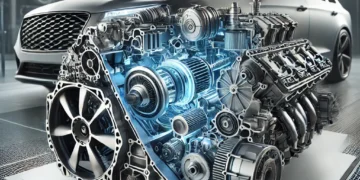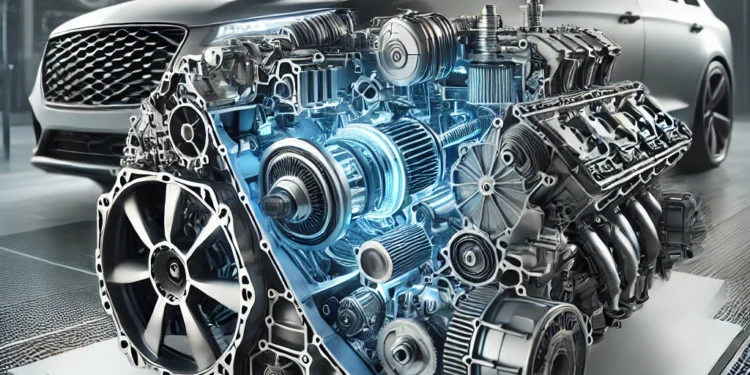In the current automotive context, advancements in engineering and vehicle design are essential for improving environmental sustainability, safety, and performance. One such innovation is the powertrain vent, a crucial part that guarantees the dependability and durability of contemporary automobiles. This article explores the main characteristics, advantages, and contributions of powertrain vents to the automotive sector, focusing on PorVent® Technology International Group, one of the leaders in venting systems.
What Is a Powertrain Vent?
An essential component of a car’s powertrain system, which consists of the engine, transmission, and drivetrain, is a powertrain vent. Controlling pressure and shielding delicate parts from environmental impurities like water, dust, and debris are its main duties.
Additionally, powertrain vents enable the system to “breathe” by balancing the pressure brought on by operating loads and temperature variations. Excess pressure can accelerate component wear and tear, impair performance, and result in leaks if it is not properly vented.
Key Features of Powertrain Vents
1. High-Temperature Resistance
Powertrain vents are made to endure the intense heat produced by the drivetrain and engine. In harsh operating situations, this guarantees steady performance.
2. Contaminant Protection
Advanced materials such as PTFE membranes are used in powertrain vents to offer strong defence against the infiltration of water, oil, and dirt. This prolongs the system’s overall lifespan and guards against harm to delicate components.
3. Pressure Equalization
4. Compact and Durable Design
Modern powertrain vents are compact, lightweight, and made of durable materials, ensuring easy integration into vehicle systems while withstanding harsh conditions over time.
Benefits of Powertrain Vents in Modern Vehicles
1. Enhanced reliability
Powertrain vents ensure consistent performance by protecting components from environmental stressors and pressure fluctuations. This enhances the reliability of the vehicle, even in extreme conditions.
2. Improved Safety
By preventing leaks and maintaining pressure balance, powertrain vents reduce the risk of component failure, ensuring safer driving experiences.
3. Increased Efficiency
Optimized pressure regulation allows the powertrain system to function at peak efficiency. This contributes to better fuel economy and reduced wear on components, minimizing maintenance costs.
4. Sustainability
With features like water and dust ingress protection, powertrain vents support longer-lasting components, reducing the frequency of replacements and promoting environmentally responsible vehicle design.
PorVent® Technology International Group: A Pioneer in Powertrain Vents
When it comes to cutting-edge venting solutions, PorVent® Technology International Group is at the forefront. Their expertise in advanced venting technologies has made them a trusted name in the automotive industry.
Why Choose PorVent® for Powertrain Vents?
- Innovation: PorVent® leads the industry with cutting-edge materials and designs tailored for modern powertrain systems.
- Reliability: Their vents are rigorously tested to meet the highest standards of durability and performance.
- Versatility: PorVent® offers solutions for various vehicle types, from passenger cars to heavy-duty trucks.
- Customization: Their ability to provide tailored solutions ensures optimal performance for specific applications.
PorVent® also integrates advanced technologies like IP rated vents to deliver superior protection against environmental challenges, ensuring that their powertrain vents remain reliable in the harshest conditions.
Applications of Powertrain Vents
Powertrain vents are critical for multiple vehicle systems, including:
- Engine Ventilation
They protect the engine from moisture and debris while allowing pressure equalization, critical for combustion efficiency. - Transmission Systems
Vents in transmission systems prevent fluid leaks and maintain optimal pressure for smooth gear transitions. - Drivetrain Components
Drivetrain systems benefit from vents that prevent dust ingress and pressure buildup, ensuring longevity and performance. - Electric Vehicles (EVs)
With the rise of EVs, powertrain vents have adapted to provide efficient venting solutions for battery and motor compartments, furthering the shift towards sustainable mobility.
Check Products From PorVent® Technology International Group
Push Fit Plug
A push fit plug is commonly used for sealing and venting applications in automotive systems. PorVent® provides innovative solutions using this mechanism to offer quick installation and secure sealing.
Screw in Vent
The screw in vent is another essential type of vent, offering easy installation and removal for maintenance. PorVent® excels in creating high-performance screw-in vents that meet global automotive standards.
IP Rated Vent
An IP rated vent ensures that components are protected against ingress of dust and water. PorVent®’s IP-rated solutions provide maximum durability and reliability for powertrain systems.
The Future of Powertrain Vents
As vehicles become more advanced, the role of powertrain vents will continue to evolve. The push toward electric and autonomous vehicles demands even greater precision and reliability from venting solutions. Companies like PorVent® are driving innovation to meet these challenges, ensuring that future vehicles remain efficient, safe, and environmentally friendly.
Conclusion
Powertrain vents are essential to modern cars’ lifetime and functionality since they make sure they run well in a variety of situations. Premium venting solutions, like those provided by PorVent® Technology International Group, can improve performance, safety, and dependability for both consumers and automakers.
Whether you drive an electric or conventional car, knowing the significance of powertrain vents can help you make wise maintenance and improvement choices. Vehicle venting is in good hands for the future thanks to companies like PorVent®.




















































